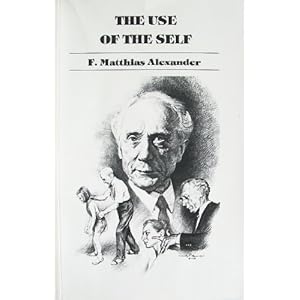Here's an example of a way of thinking that applies the Alexander Technique to the experience of suffering. This process may be learned more easily with an Alexander teacher, but ultimately our best teacher is the one inside each and every one of us (after all, F.M. Alexander never had a teacher; all he had was himself and a mirror!). Alexander lessons can help us get in touch with our "Inner Teacher".

The process consists of simply:
- Noticing what is
- Taking time
- Allowing what is
- Being aware of our inherent freedom
- Choosing what we want, where we want to be
- Stopping
- Aiming
Noticing:
I am tight, twisted, contorted
I am aiming myself inwards, downwards
Collapsing
Tightening, stiffening
I feel pain...grief...I don't like this!
I feel awful, miserable...everything hurts...
my neck is tight...
What is my Goal?
I want..........
What do I REALLY want?
Giving myself time...
Waiting...
Letting myself feel whatever I am feeling right now...
Allowing myself to move and be moved...
Witnessing, observing, noticing what is moving within me...
I want to find joy and happiness again...
freedom from suffering...
relief from pain...
joy, lightness, ease...
I have time...
I have free will...
I am free to feel
free to move
free to be how I am right now
free to want what I want
free to think what I think
free to experience this present moment, just as it is
free to experience who I am, right now
free to feel terrible, miserable
free to feel fear, desperation, panic, grief, depression...
I am free to stop thinking in a way that pulls me down
I am stopping
I am free to choose what direction to go in
I am free to aim, to wish, to desire what is best for me
I am free to not-know
I am free to not-do
I am free to wonder, free to get curious...
I am free
my mind-body-self is free to be just as it is
I am free to be mySelf
I am free to stop getting in the way of my true nature
I know that my True Nature is Freedom
Consciousness
Beauty
Love
Goodness
Up-ness
Light-Heartedness
Joy
no matter how I feel, I know this is true
I want to go up, be up, aim up
I know where I am, and I know where I want to go
I know where the ground is beneath my feet
I know where the sky is above my head
the neck is free
I am aware of the forward space
I am aware of where the sky is
I am aware of forward and up
the neck is free
the head remembers forward and up
the whole self lengthens, widens, expands
breathes
Here
Now
One with everything, inside and out
Becoming Me...
This is Me
One simple thought:
Always remember where the sky is!


























